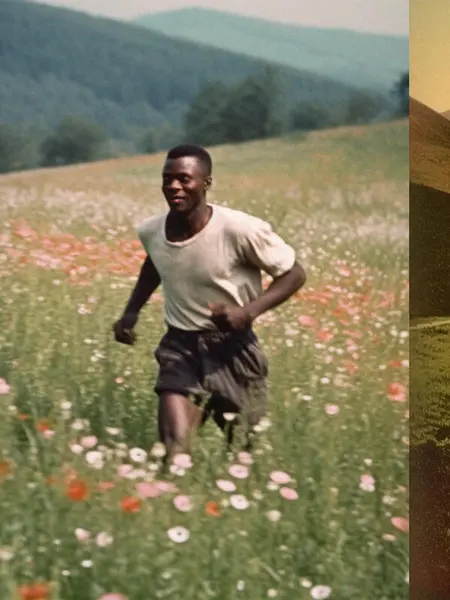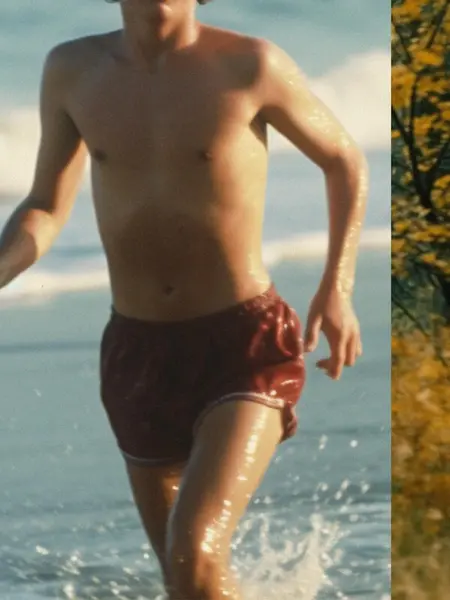- 1/1
© Sander Coers, POST / X, 2023
Som barn tilbrakte Coers timer fordypet i besteforeldrenes fotoalbum der han oppdaget en del av familiehistorien sin knyttet til bestefarens fødsel i Indonesia under andre verdenskrig. Men det hersket en taushet rundt fortiden, noe som gjorde det vanskelig for ham å forstå hele historien.
- 1/1
© Sander Coers, POST / XI, 2023
For å bygge bro over dette gapet bestemte han seg for å trene en AI-robot til å utvide familiehistorien basert på besteforeldrenes fotoalbum fra 1940- til 90-tallet. Disse AI-genererte bildene bruker lignende elementer som finnes i besteforeldrenes album. Alt er imidlertid fullstendig falskt. Ved å kombinere den visuelle stilen til besteforeldrenes album med sin enorme database, kommer AI-boten opp med en mørkhudet mann som løper gjennom et felt med blomster, lokalisert i det som ser ut til å være Alpene. Det er et bilde som ikke nødvendigvis er forankret i vår visuelle minne, og lager dermed en helt ny fortelling.
- 1/1
© Sander Coers, POST / XIX, 2023
Koblingen mellom minnebegrepet og maskulinitet i dette prosjektet er mangefasettert. På den ene siden spiller hukommelsen en betydelig rolle i å forme vår oppfatning av maskulinitet over tid. Ved å se på de tilbakevendende symbolene i de AI-genererte bildene, som dresser, belter og hatter, kan vi se hvordan disse har blitt brukt som stereotype visuelle markører for maskulinitet gjennom ulike tidsepoker. På den annen side utforsker prosjektet også ideen om at selve hukommelsen, i likhet med maskulinitet, er en konstruksjon. Noe som kan manipuleres og fabrikkeres. Dette reiser spørsmål om autentisiteten til minnene våre, og hvordan vår oppfatning av maskulinitet kan formes av konstruerte minner i stedet for faktiske opplevelser.
Her kan du lese Sander Coers prosjektbeskrivelse
POST, 2023
Project description
POST explores the intersection of constructed memories and perceptions of masculinity in visual culture through the use of AI-generated imagery. With this project, I aim to investigate the role of photography in shaping our perceptions of the past and question its authenticity in the age of digitalism where memories can be constructed and manipulated.
As a child, I spent hours immersed in my grandparents' photo albums, fascinated by the details in each picture. I longed to connect with the people captured in those images and to have a glimpse into the past of my grandfather. In those albums, I discovered a part of my heritage tied to my grandfather's birth in Indonesia during World War II. But there was a silence surrounding the past, making it difficult to grasp the full story.
To bridge that gap, I decided to train an AI bot to expand my family history based on my grandparents’ photo albums ranging from the 1940’s to the 90’s. These AI-generated images evoke similar elements found in my grandparents' albums - landscapes, clothing, and colors from that time. However, everything is completely false. Combining the visual style of my grandparents' albums with its vast database, the AI bot comes up with a dark-skinned man running through a field of flowers, located in what seems to be the Alps - an image that is not necessarily rooted in our visual memory. It's interesting to see how the bot makes room for a new narrative.
The link between the concept of memory and masculinity in this project is multifaceted. On the one hand, memory plays a significant role in shaping our perceptions of masculinity over time. By looking at the recurring symbols in the AI-generated images, such as suits, belts, and hats, we can see how these have been used as stereotypical visual markers of masculinity through different eras. On the other hand, the project also explores the idea that memory itself, like masculinity, is a construct. Something that can be manipulated and fabricated. This raises questions about the authenticity of our memories, and how our perceptions of masculinity might be shaped by constructed memories rather than actual experiences.
The photos are UV-printed on plywood, often used in construction - a stereotypical masculine environment. By printing the images on this material, I create a physical representation of the constructed memories that we hold onto. The images become tangible objects that reflect the fragility of our memories


